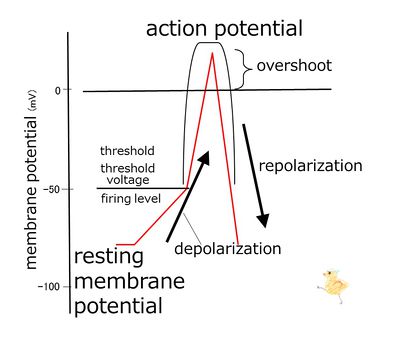Nerv06/introduction/terms regarding membrane potential
Inside the cell membrane at rest, a negative potential is being generated. With stimulation, this negative potential decreases. This is called depolarization. When the membrane potential decreases to a certain level, an active potential, called the action potential is generated. The voltage this transaction occurs, is called the threshold, threshold voltage, or firing level.
The characteristics of the action potential are rapid depolarization and overshoot. Overshoot means switching of the electric polarity in and outside the cell membrane, making it positive inside.
After overshoot, the negative polarity again increases rapidly, and the action potential ends, returning to resting membrane potential. This process is called the re-polarization.
Challenge Quiz
The process of the (absolute voltage of the) resting membrane potential decreasing and the neuron being activated is called hyperpolarization.depolarization .
The neuron cell membrane repolarizes.depolarizes when stimulated.
When the membrane potential depolarizes to the firing level (threshold, threshold voltage), the action potential is. is not generated.
When the membrane potential depolarizes even a small amount from the resting membrane potential, action potential would always be generated. true.false
When a neuron is stimulated and an overshoot generated, the electrical potential is switched and inside the membrane becomes positive. negative .
After overshoot, the membrane depolarizes.repolarizes to resting membrane potential.
